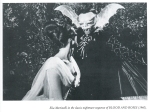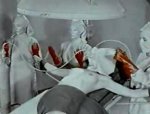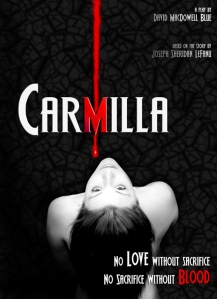 A character often omitted from LeFanu’s story is the peddler, the first to suspect there’s perhaps something odd about Laura’s visitor.
A character often omitted from LeFanu’s story is the peddler, the first to suspect there’s perhaps something odd about Laura’s visitor.
So tell me about yourself. Who is Irwin Moskowitz?
Growing up in Pittsburgh, I spent many Saturday afternoons at the movies. And I watched every movie I could back in the day when there were only three channels. Among the many films I watched were the early talkies including Dracula and Frankenstein. I like to point out that the budget on the original Dracula was so small, it did not include music/soundtrack. See it today and there’s no music, like Hitchcock’s The Birds. But I digress. A movie lover from the get-go, guilty as charged.
I already know the answer, but how did you come to be involved in Carmilla?
Answering an Actor’s Access call for Carmilla, I auditioned for the role of Laura’s father and other characters, including The Peddler. Carmilla’s story has moved to 1938 Austria prior to the onset of WWII. To me, The Peddler (“Carlsberg”), represents a minority figure unlikely to survive the war. He must do what he can to survive in a hostile, cruel environment, yet provides some humor in the melodrama. I like to paraphrase Stanislavsky…There are no small parts, only small paychecks.
Were you at all familiar with the story before this?
I was not at all familiar with Carmilla or its story line prior to my audition. I’d seen countless productions of all types involving vampires, but this is my first time actually working in one.
Are you a particular fan of gothic or vampire fiction?
Who doesn’t love vampire and gothic horror stories/films? I’d seen the early B&W films on the Late Late Show, called Academy Theater in Pittsburgh, during the dark ages. Also saw the Hammer films of the sixties, with Christoper Lee, for one, in living color. The vampire renaissance likely started in the Seventies with Anne Rice’s Interview With a Vampire, but the number of films, et. al., about vampires since then are countless. And now they’re on TV/cable and popular. If anything can distract most people from their daily lives/grinds, it’s vampires. What if? If Only? Wouldn’t that be_________________________? Fill in the blank. Plus, vampires are sexier than most antagonists so they’ve got that going for them, in addition to living forever. You call that living? No days, only nights. Can’t imagine they make a Serta PerfectSleeper to fit a coffin. You have to imagine your hair looks ok because you can’t see your reflection in a mirror. And, although most everyone likes garlic, let’s be reasonable. And who delivers blood when you’re hungry/thirsty? You have to get your own! Or have “people” get it for you. Like assistants. It’s gotta be a tough life, or whatever.
You’ve made an interesting contribution to the script itself since being cast. Care to tell that story?
No.








